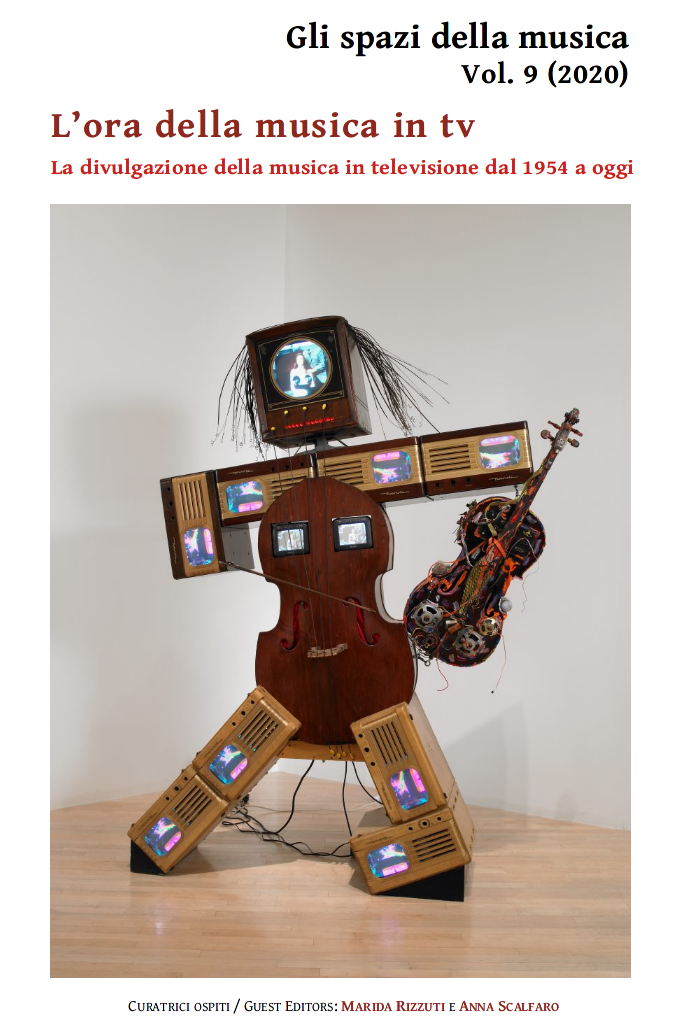La divulgazione musicale in Rai-tv fra gli anni Sessanta e Ottanta. ‘Specchio sonoro’ di Roman Vlad (1964) e ‘Tutto è musica’ di Vittorio Gelmetti (1980)
Abstract
Nei primi trent’anni di attività (il servizio televisivo viene inaugurato il 3 gennaio 1954), la divulgazione musicale in Rai-tv si esplica, oltre che con la messa in onda di eventi operistici e sinfonici, anche con l’ideazione e realizzazione di programmi pedagogico-educativi. Sul Secondo canale, in particolare, la Rai produce alcuni programmi affidati a noti musicologi: è il caso di Specchio sonoro, in cui Roman Vlad illustra vita e opere di grandi compositori del Novecento (Bartók, Stravinskij, Prokof’ev, Schönberg, Berg e Webern), inquadrandoli nel contesto storico-culturale e illustrandone lo stile mediante esemplificazioni al pianoforte. Nel decennio successivo i programmi con espliciti intenti educativi, dominati dalla figura del docente-esperto, cedono il passo a programmi più vicini al genere “inchiesta”, in cui predomina l’approfondimento della notizia, l’indagine della dimensione attuale. Nei tredici appuntamenti di Tutto è musica (1980), il compositore Vittorio Gelmetti tenta di affrontare il “fenomeno musica” sotto svariati punti di vista, evitando distinzioni qualitative di generi, epoche e civiltà.
Mediante l’analisi di queste due trasmissioni a puntate – Specchio sonoro e Tutto è musica – il saggio intende porre in luce due diversi modi di divulgare la musica in televisione, corrispondenti a quelle fasi della televisione italiana che Umberto Eco ha compendiato nelle definizioni “paleo-tv” e “neo-tv”.
In its first thirty years of activity (the television service started on January 3, 1954), Rai-tv popularised art music not only by airing opera and symphonic events, but also by designing and producing pedagogical and educational programmes. Particularly on the Second channel, Rai produced a few programmes on art music led by important musicologists: it is the case of Specchio sonoro, in which Roman Vlad illustrates the life and works of 20th-century great composers (Bartók, Stravinskij, Prokof’ev, Schönberg, Berg, and Webern), setting them in their historical and cultural context and explaining their style by playing their pieces on the piano. In the following decade, programmes with explicit educational goals, led by expert-lecturers, give way to programmes that are more related to the genre of “investigation”, where in-depth news analysis and the investigation of current dimension prevailed. In the thirteen episodes of Tutto è musica, composer Vittorio Gelmetti attempts an analysis of the “musical phaenomenon” under several perspectives, avoiding qualitative distinctions between genres, periods of time and civilisations.
Through the analysis of these two broadcasts – Specchio sonoro and Tutto è musica – the essay aims to highlight two different ways of divulging music on television, corresponding to those phases of Italian television that Umberto Eco summarised in the definitions “paleo-tv” and “neo-tv”.

Quest'opera è distribuita con licenza Creative Commons Attribuzione - Non commerciale - Non opere derivate 3.0 Unported. Tutti i diritti relativi a quanto pubblicato su «Gli spazi della musica», compreso il diritto di pubblicazione, restano di proprietà esclusiva degli autori.





